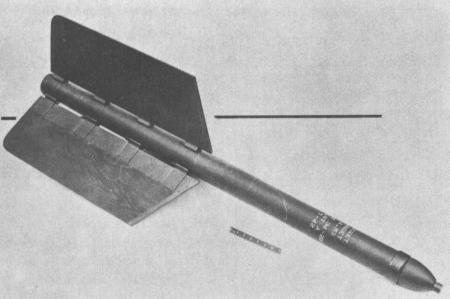3.25 inch Anti-Aircraft Target Rocket M2
During World War 2, the U.S. Army developed the 3.25 inch Anti-Aircraft Target Rocket M2 to provide anti-aircraft gunners a training target which could simulate low-flying high-speed aircraft. The M2 was fired from a mobile launcher, and in exercises many rockets could be quickly fired in different directions for more realistic combat training. The solid-propellant rocket was fitted with three especially large plywood fins to facilitate optical spotting of the target.
 |
| Photo: via Ordway/Wakeford |
| Anti-Aircraft Target Rocket M2 |
In the M2A1 night-time training variant, the nose cap was replaced by a flare assembly. This was eventually superseded by the M2A2, which also featured the flare in the nose, but had modified igniter and internal wiring.
Specifications
Data for Anti-Aircraft Target Rocket M2:
| Length | 1.50 m (4 ft 11 in) |
| Diameter | 8.3 cm (3.25 in) |
| Weight | 16 kg (35 lb) |
| Speed | 580 km/h (360 mph) |
| Range | 1.6 km (1 mile) |
| Propulsion | Solid-fueled rocket |
Main Sources
[1] Frederick I. Ordway III, Ronald C. Wakeford: "International Missile and Spacecraft Guide", McGraw-Hill, 1960
[2] War Department: "Technical Manual TM9-1950, Rockets", July 1945
[3] Department of the Army: "Technical Manual TM9-1950, Rockets", June 1950
Back to Directory of U.S. Military Rockets and Missiles, Appendix 4
Last Updated: 8 June 2024